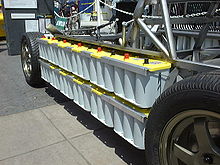AC Propulsion tzero


The tzero , proper spelling of the manufacturer's t zero (pronounced tisiero ) is a motor vehicle with electric drive , the American US by the company AC Propulsion was built as a development platform. Three examples were hand-built and two were sold to private individuals after the plan to mass-build the vehicle was abandoned in 2003. One of the three copies built fell victim to a fire in late April / early May 2017. The drive concept was licensed by AC Propulsion for the Tesla Roadster . The name tzero refers to the symbol “t 0 ” for “start time” or “beginning”.
AC Propulsion competed with the vehicle in technical demonstrations against numerous sports cars with combustion engines to demonstrate the superiority of electric cars and AC Propulsion drives, for example against the Corvette C4 . The car reaches speeds of around 160 km / h, or 100 miles per hour (mph) and accelerates from 0 to 60 mph (0 to about 96 km / h) in 4.07 seconds.
technology
The chassis is a lattice frame made of tubular steel, the roadster body with removable roof is made of fiberglass-reinforced plastic . The carriage is driven by an AC-150 ( asynchronous motor ) of a maximum of 160 kW (215 hp ), according to other data output of 220 kW and a maximum of 13300 min -1 achieved. He weighs about 50 kg. It drives the vehicle via a gearbox with a ratio of 9: 1. The motor is operated by a frequency converter weighing around 30 kg (in which the 20 kW charger is also integrated) and can deliver its maximum torque of 225 Nm from standstill to a speed of 5500 min −1 . Therefore there is no clutch and no gear shift. All wheels are individually on each of two unequal length wishbones hung, front rack & pinion steering is fitted. There are disc brakes on all wheels , the brake discs are made of Duralcan, an aluminum alloy reinforced with silicon carbide .
Batteries
Depending on the battery set it is equipped with, the car has a range of up to 480 km. In the version with lead-glass fleece accumulator batteries , the car weighs 1134 kg (2500 lbs) and you can drive about 130 km with fully charged batteries. Alternatively, there was also the version with 50 kWh from lithium-ion batteries , which weighs 350 kg (vehicle: 894 kg) and can travel up to 480 km. (According to manufacturer information)
For this purpose, the manufacturer offered a trailer on which a Kawasaki 500 cm³ engine, coupled with a 20 kW generator, is installed. With this it is possible to drive longer distances without reloading. The fuel consumption is then around 6.7–7.8 l / 100 km (35 to 30 mpg ).
Recuperation
The tzero uses recuperation to recover energy. As soon as the driver takes his foot off the accelerator, the car begins to brake slightly by converting the car's kinetic energy into electricity and thereby recharging the batteries. The engine runs as a generator. With the exception of possible emergency braking, the tzero can only be driven using the accelerator pedal. This increases the range of the tzero by up to 30% in inner-city traffic.
See also
Web links
- tzero Previous website ( Memento from August 15, 2008 in the Internet Archive )
- tzero Current website
Individual evidence
- ↑ Archive link ( Memento from July 14, 2014 in the Internet Archive )
- ↑ Fred Lambert: A piece of electric car history up in flames: several Tesla Roadsters and original Tzero lost in devastating fire. electrek.co Internet portal, May 11, 2017 (English)
- ↑ - ( Memento from August 19, 2017 in the Internet Archive )
- ↑ http://de.temponik.com/Duralcan%C2%AE-1
- ↑ https://web.archive.org/web/20081001115437/http://www.acpropulsion.com/tzero/tzero.pdf
